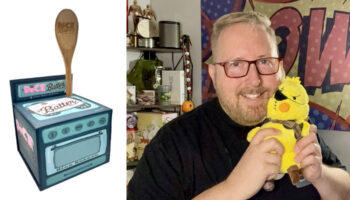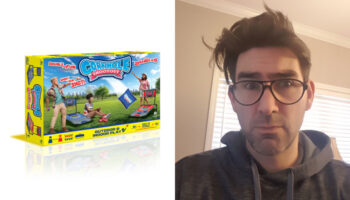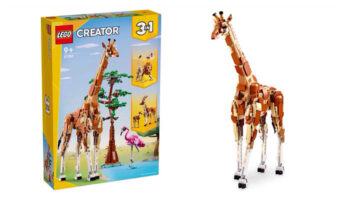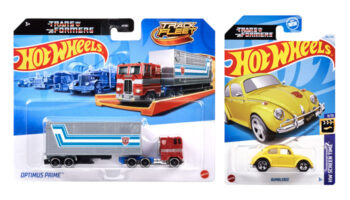“It’s a game and soundtrack in one!”: Inventor Marcus Carleson and Jumbo’s Ferran Codina on the story behind Hitster

Marcus, Ferran, thanks for making time to talk about Jumbo’s exciting new game, Hitster. Marcus, you invented the game – how does it play?
Marcus Carleson, Hitster inventor: Nice to meet you! Hitster is a game where you listen to over 100 years of hits and take turns placing them in chronological order on your music timeline. You don´t need to know the exact year the songs were release, only if there were released before or after other songs.
If you can also name the artist and song title you are awarded a Hitster-token, which can be used in three different ways… One: steal your opponent’s cards. Two: Change the song you are tasked with placing on your timeline. Or Three: swap three tokens for a free music card on your timeline. The first player to collect 10 hits in the right order wins.
And each card has a QR code that plays each song – a party game that actually sounds like a party!
MC: Well, “Hitster is a game and a soundtrack for your party in one” was a review we received early on and that I think sums it up nicely. It keeps everyone engaged no matter who’s turn it is – and it can trigger the most wonderful conversations around song memories.
It’s also very age inclusive. We often hear that families play in teams across three generations – but you could just as well play it as an afterwork game or with your crew before hitting the club.

Where did the idea for the game come from?
MC: It started on a dinner party back in the summer of 2019. I have always enjoyed arranging games and quizzes, and this time I had prepared a number of pieces of paper with artist names, song titles and the song release year. There was of course no QR-scanning involved, so I played the role as dedicated DJ.
And it went down well?
MC: It was a big hit! My guests absolutely loved it! I couldn´t let the idea go but kept thinking about if this was a one-off thing or if I was really onto something that others would enjoy too. To find out, I developed some really simple prototypes that I play-tested together with friends and family that summer – and to my delight, the response was the same!
Did the concept evolve much from that first idea to the finished game?
MC: Yes and no. The very first concept that I used has stayed the same throughout the development process, but it has indeed been refined along the way. The development can be summarised in three categories…
Great, what’s the first?
MC: Making it simpler to play the music… I realised that simplicity would be a key aspect with regards to figuring out how to play the music automatically, rather than having one person typing in every song. But equally important was how the DJ could start the music without seeing what comes on, so that everyone could also take part in the game.
Ah! A problem solved by the QR codes on the back of each card.
MC: Yes, eventually! But as a start-up I didn’t have the financial resources for sophisticated technical solutions such as app development. Instead, I figured out a way for how the box could solve this, which can be seen in the first version of the game that was released on Kickstarter.

We have a shot of the original version there… So you’d slide your phone into the box without seeing the card – nice solution! What was the second key area of development?
MC: Greater depth in game mechanics. Even though the game concept seemed to work great, I figured that it needed something more to add another layer to the game mechanics, which resulted in the tokens. New tokens can be earned if you – on your turn – can name the correct artist and song title. I experimented with different functions but eventually settled with steal, swap, and trade.
By introducing the tokens I think the game becomes more appealing to a wider audience. The stealing mechanism keeps everyone involved even when it is someone else’s turn. The swap mechanism allows for your grandmother to stop the house hit – or for that matter a tactical player who has several cards in a tight timespan – to get another shot. The trade mechanism allows for really skilled players to get use for their knowledge.
Smart.
MC: I also had a concern that the original gameplay would be too easy for advanced players. The solution came in two parts. First, I moved the rules from being included in the box as they normally are to being purely digital. So, you would scan a QR-code and your phone would open the rules. Then I realised that this presented the opportunity to do something you would see in old video games, where you are presented with the question to choose difficulty, so I introduced three difficulty levels – “original”, “pro” and “expert” – with slightly different rules. This way, players on different levels can even play in the same game.
Design
The design developed gradually and I had many different ideas for the concept with a lot of different prototypes. Testing was key and initially the box itself was a crucial part for starting the music, which in turn set the framework for the dimensions of the box. I also needed artwork that would use that to its advantage. This eventually resulted in the double speaker that can be seen on the original game on Kickstarter.
As you say, you launched the original game on Kickstarter. What appealed about that route?
MC: This was my first game and with no previous experience in the industry – the options were quite limited. I could of course gamble on that some retailers would pick it up, but as a start-up I had very limited resources to even start production. Kickstarter seemed like an appealing option. And to be honest, I thought Hitster was at least as innovative as many other products that have been successfully launched on Kickstarter.
So how did the game find its way to Jumbo?
MC: They noticed the Kickstarter campaign and that the product fitted with where they were going. We started talking and I think we both saw the same potential in the game. With no experience in the industry, I asked around the best I could what people with insight thought of Jumbo and the same answer popped up time and again: “They are the good guys”.
Today, after having known them for some time I can do nothing but agree – they have been wonderful in every aspect from the very start. Just kind, knowledgeable, honest people with the purest intentions. I am so thankful for our collaboration and not the least for that Jumbo believed in it.

“Kind, knowledgeable, honest.” That’s a nice place to bring you in Ferran! You are Group Brand Manager for Games at Jumbo. What does the role entail?
Ferran Codina, Group Brand Manager for Games, Jumbo: I oversee the strategic planning, development, and execution of the games portfolio. My responsibilities include managing the product line-up, defining the brand strategy, collaborating on product development, implementing marketing campaigns, and ensuring effective sales and distribution. I also lead a team, analyse market trends and make data-driven decisions to drive the success of our games division.
What was it about Hitster that made it a compelling game for Jumbo?
FC: Its unique and innovative gameplay resonates with a wide audience. The game creates an immersive and entertaining experience for players. Moreover, Hitster’s engaging and accessible mechanics make it easy for both casual and experienced gamers to enjoy.
The game blends physical and digital play. What’s the key to getting that balance right in a board game?
FC: For me, the key to balancing physical and digital elements in board games would be seamless integration through well designed, user-friendly, intuitive interfaces and maintaining the tactile experience by incorporating physical components like cards and tokens.
It’s also important to preserve social interaction, balance complexity and the digital aspects should serve a purpose and enrich the gaming experience. Future-proofing is also key – you need the ability to adapt the game for future technology advancements.

Great points. Marcus, back to you for a moment. Have you been bitten by the game design bug? Will we see more games from you?
MC: Oh, yes! I have come to be fascinated by games in the digital/physical space and I´m currently working on a number of new projects. I hope to be able to tell you a bit more in the near future!
Yes, keep us posted. And what helps you have ideas? What fuels your creativity?
MC: That´s a good question. I usually just start with one very specific thing – it could be something like a vision for something very specific that should happen in the game. And then I try to picture how a gameplay could work around that one thing I started with.
Inspiration for new ideas or solutions to old ones could come from anywhere, so I try to step in and out of the creative thinking from time to time during the days. The mind picks up things in your environment all the time, and without knowing it that could be just the thing that is needed to solve some key aspect of a game concept.
Fantastic. Ferran, before we wrap up, what else from Jumbo should we keep an eye out for on the games front?
FC: Jumbo’s recent titles include the new version – Hitster: Guilty Pleasures – in certain countries. Exciting upcoming releases are also on the horizon, promising innovative gameplay and immersive experiences. Stay tuned!

We will! Last question Ferran, I haven’t asked you how you found your way into this industry – what was your route?
FC: I have always found the toys and games sector to be a fascinating industry. However, it wasn’t initially part of my plan. My journey into this sector was shaped by my previous work experiences. I began my career in fast-moving consumer goods, which allowed me to gain insights into consumer behaviour and market trends.
Later, I moved into the publishing industry, specifically focusing on products targeted towards kids. This experience exposed me to the world of children’s entertainment and the importance of understanding the preferences and interests of young audiences.
Ultimately, my path led me to work at a toy company, where I spent over six years. During my time there, I developed a deep appreciation for the creativity and innovation that goes into designing and producing toys and games.
Great stuff. Huge thanks again guys – and congrats on Hitster!
–
To stay in the loop with the latest news, interviews and features from the world of toy and game design, sign up to our weekly newsletter here



























